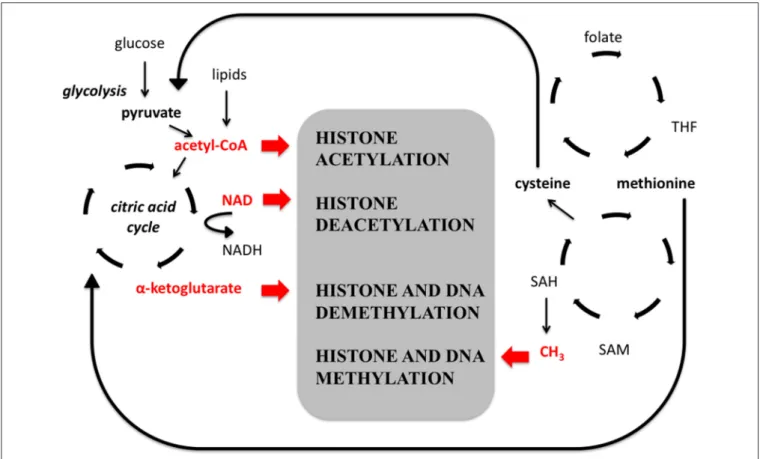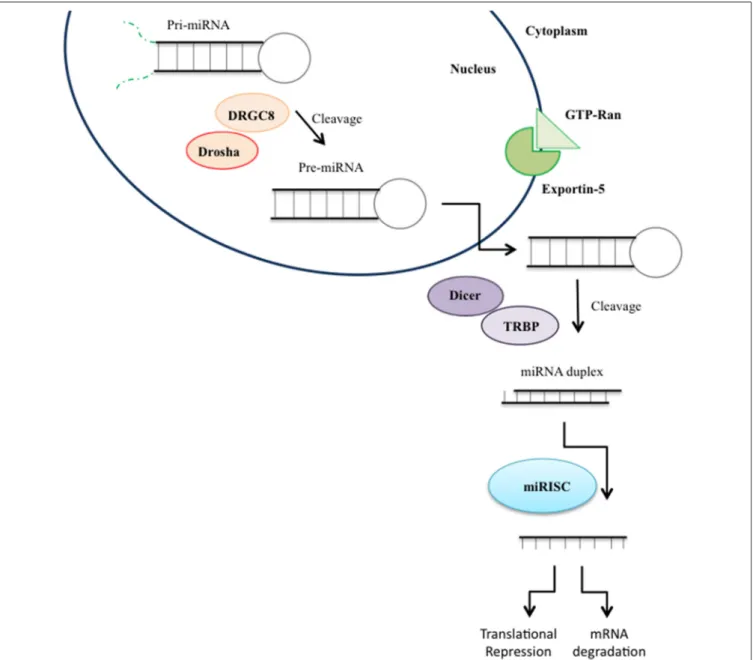Edited by:
Kirsten R. Müller-Vahl, Hannover Medical School, Germany
Reviewed by:
Munis Dundar, Erciyes University, Turkey Thomas V. Fernandez, Yale University School of Medicine, USA
*Correspondence:
Tamás Arányi aranyi.tamas@ttk.mta.hu Csaba Barta barta.csaba@
med.semmelweis-univ.hu
Specialty section:
This article was submitted to Child and Adolescent Psychiatry, a section of the journal Frontiers in Neuroscience
Received:29 April 2016 Accepted:06 June 2016 Published:12 July 2016
Citation:
Pagliaroli L, Vet ˝o B, Arányi T and Barta C (2016) From Genetics to Epigenetics: New Perspectives in Tourette Syndrome Research.
Front. Neurosci. 10:277.
doi: 10.3389/fnins.2016.00277
From Genetics to Epigenetics: New Perspectives in Tourette Syndrome Research
Luca Pagliaroli1, 2, Borbála Vet ˝o2, Tamás Arányi2, 3* and Csaba Barta1*
1Institute of Medical Chemistry, Molecular Biology and Pathobiochemistry, Semmelweis University, Budapest, Hungary,
2Research Centre for Natural Sciences, Institute of Enzymology, Hungarian Academy of Sciences, Budapest, Hungary,
3Centre National de la Recherche Scientifique UMR 6214, Institut National de la Santé et de la Recherche Médicale U1083, University of Angers, Angers, France
Gilles de la Tourette Syndrome (TS) is a neurodevelopmental disorder marked by the appearance of multiple involuntary motor and vocal tics. TS presents high comorbidity rates with other disorders such as attention deficit hyperactivity disorder (ADHD) and obsessive compulsive disorder (OCD). TS is highly heritable and has a complex polygenic background. However, environmental factors also play a role in the manifestation of symptoms. Different epigenetic mechanisms may represent the link between these two causalities. Epigenetic regulation has been shown to have an impact in the development of many neuropsychiatric disorders, however very little is known about its effects on Tourette Syndrome. This review provides a summary of the recent findings in genetic background of TS, followed by an overview on different epigenetic mechanisms, such as DNA methylation, histone modifications, and non-coding RNAs in the regulation of gene expression. Epigenetic studies in other neurological and psychiatric disorders are discussed along with the TS-related epigenetic findings available in the literature to date.
Moreover, we are proposing that some general epigenetic mechanisms seen in other neuropsychiatric disorders may also play a role in the pathogenesis of TS.
Keywords: Tourette Syndrome, genetics, epigenetics, DNA methylation, non-coding RNA, neurological disorders, psychiatric disorders
INTRODUCTION
Gilles de la Tourette Syndrome (TS) is a neurodevelopmental disorder characterized by one vocal and multiple motor tics, lasting longer than a year (Robertson, 2000). The prevalence of TS is estimated to be∼1% and it occurs more in males than females, with a ratio of 4 to 1, without differences between social classes. Furthermore, in almost 90% of cases, TS arises along with comorbid neuropsychiatric disorders: in 45–60% with obsessive-compulsive disorder (OCD), while in 60% of cases with attention deficit hyperactivity disorder (ADHD). Anxiety, behavioral disorders, autism spectrum disorders, and learning disabilities are also quite common among individuals with TS (Baron-Cohen et al., 1999; Coffey et al., 2000; Kurlan et al., 2002; Burd et al., 2005; Robertson and Orth, 2006; Cavanna and Termine, 2012; Robertson, 2012).
Tics are defined as sudden movements or vocalizations that are recurrent, rapid, arrhythmic, and stereotyped. They decline in situations of distraction and relaxation, while they increase under stress and anxiety. It is generally preceded by premonitory urges or a sense of inner tension that is reduced or relieved by the performance of the tic (Kwak et al., 2003). Motor tics can be classified
as (i) simple, involving single muscle or small group of muscles such as the case of blinking, eye rolling, nose twitching; or (ii) complex, requiring a coordinated pattern of movement or sound like touching, squatting, jumping. In the case of vocal tics, sniffing, throat clearing, snorting, gulping, and coughing are classified as simple; while barking, making of animal noises, and uttering strings of words are classified as complex (Robertson, 2012). The most common manifestation is the eye blinking, which is often the first to appear as well. The typical age of onset ranges from 2 to 21 years with a mean at 7 years. Tourette Syndrome is characterized by a waxing and waning course, peak symptom intensity is usually noted in late childhood. The decline of symptoms is usually in late adolescence or early adulthood (Fusco et al., 2006; Stillman et al., 2009).
THE GENETIC BACKGROUND OF TOURETTE SYNDROME
Like many other neuropsychiatric disorders, TS also has a complex etiology. Several environmental risk factors have been identified, such as perinatal hypoxia, maternal smoking during pregnancy, exposure to androgens, heat, and fatigue (Swain et al., 2007). These environmental factors may interact with many underlying genetic risk factors. To assess the overall genetic contribution in developing a disorder or trait, heritability estimates can be determined, which usually vary between different studies. Based on a recent meta-analysis of all human twin studies to date, the heritability of tics/tic disorders is 0.45 (Polderman et al., 2015). The two most recent studies on the heritability of TS and tic disorders estimated them to be 0.58 and 0.77, respectively (Davis et al., 2013; Mataix-Cols et al., 2015).
The risk for first-degree relatives was significantly higher than for second-degree relatives (odds ratios 18.7 and 4.6, respectively).
Despite this relatively large overall genetic contribution, most individual gene variants have only very small effects. Hence, most of the earlier studies attempting to unravel the genetic architecture of TS have been hampered by low statistical power due to small sample sizes and clinical heterogeneity. Linkage and candidate gene association studies have identified a number of chromosomal regions and gene polymorphisms possibly implicated in Tourette Syndrome. The candidates for these small scale studies have traditionally been variations in genes involved in the dopaminergic and serotonergic neurotransmitter systems, generally due to their suspected contribution to the etiology of other psychiatric disorders often comorbid with TS, such as ADHD, OCD, autism, etc.
The studied genetic variations are classified in different categories based on the extent of DNA alteration, including single nucleotide polymorphisms (SNPs), as well as shorter or longer repeat variants, such as variable number of tandem repeats (VNTRs) and copy number variations (CNVs). SNPs are the most common form of genetic variation in humans.
A SNP represents the change of a single base-pair (bp) in the individual’s DNA sequence. The frequency of a particular SNP can vary from private mutations (i.e., only one individual possesses the variation due to a de novo mutation) to very
common polymorphisms found in almost half of the population.
Millions of SNPs exist in an individual’s genome, however, most of them are presumed to be neutral, but some may alter gene expression or cause structural changes in the encoded proteins (and other transcripts). Due to this, many SNPs are known to be associated with various human traits and diseases. VNTRs are polymorphisms in the genome where a short sequence of nucleotides (usually up to 100 bp) is organized in multiple copies, which are clustered together and oriented in the same direction. The copy number can vary between individuals and this may influence gene expression or protein structure. CNVs represent much larger genetic rearrangements (usually thousands to millions of base-pairs in length) and therefore change the copy number of genes within the region due to the deletion or duplication of a chromosomal segment. Gene variants implicated in TS are summarized inTables 1,2.
Most genetic findings implicated in the pathogenesis of Tourette Syndrome to date are inconsistent and studies yielding positive results lack replication in other independent cohorts.
On the other hand, some nominally significant candidate gene associations might suffer from lack of proper statistical correction for multiple testing (e.g., Bonferroni correction). However, there are some examples for positive replications as well, these are summarized inTable 1. During the recent years meta-analyses confirmed the role of SLITRK1, NTN4, DRD2, DRD4 and AADAC gene polymorphisms in TS (Liu et al., 2014; Paschou et al., 2014; Yuan et al., 2015; Bertelsen et al., 2016). Here, we will review most of the genes that have been consistently replicated in TS. Single positive findings are summarized inTable 2and are not discussed in detail.
SLITRK1 is a member of the SLIT and TRK family, a type-I transmembrane protein with an extracellular leucine-rich repeat domain homologous to SLIT (Aruga and Mikoshiba, 2003). It is involved in the control of neurite outgrowth and it is expressed during both embryonic and postnatal development of the cortex, thalamus and the basal ganglia, the neuroanatomical structures believed to be affected in TS (Proenca et al., 2011). The gene coding for SLITRK1 is one of the most studied in relation with Tourette Syndrome. In 2005, a de novo inversion at chromosome 13q33.1 and two additional rare variants were identified in TS patients in the region including a single nucleotide deletion causing a frameshift and a truncated protein and a mutation in the 3′ untranslated region (3′UTR) at the putative binding site for microRNA hsa-miR-189 (Abelson et al., 2005). Since the original discovery several studies in various populations have attempted to replicate the association with controversial results.
In a family study of Canadians, a common variation rs9593835 and two haplotypes were found to be associated with the disorder (Miranda et al., 2009). These results were also confirmed in a large sample of European trios with TS (Karagiannidis et al., 2012). A recent study on SLITRK1 found a significant difference in the distribution of haplotypes consisting of SNPs rs9546538, rs9531520, and rs9593835 between Japanese patients and controls (Inai et al., 2015).
Only one genome-wide association study (GWAS) has been published to date in TS by a large international consortium including a sample of 1285 cases and 4964 ancestry-matched
TABLE1|Multiple(positive)findings. GeneFullgenenamePUBMEDIDTypeofanalysisVariationSamplesizeEthnicityReferences AADACArylacetamidedeacetylase13CNV,meta-analysisDeletion243TSpatients,1571controlsEuropeanBertelsenetal.,2016 BTBD9BTBdomaincontaining9114781SNPrs9296249110TSpatients,440controlsHanChineseGuoetal.,2012 SNPrs4714156,rs9296249, rs9357271322TSpatients,290controlsFrenchCanadianRivièreetal.,2009 DRD2/ANKK1DopaminereceptorD2/ankyrin repeatandkinasedomain containing1
1813/255239SNPTaqIA/rs1800497523TSpatients,564controlsEuropean,AsianYuanetal.,2015 SNPrs6279,rs1079597,rs464831869TStriosAntioquianHerzbergetal.,2010 SNPTaqIA/rs1800497151TSpatients,183controlsTaiwaneseLeeetal.,2005 SNPTaqIA/rs1800497274TSpatients,714controlsEuropeanComingsetal.,1996b SNPTaqIA/rs1800497147TSpatients,314controlsEuropeanComingsetal.,1991 DRD4DopaminereceptorD41815VNTR48bpexon3VNTR291TSpatients(218trios),405controlsHanChineseLiuetal.,2014 VNTR48bpexon3VNTR110TStriosFrenchCanadianDíaz-Anzaldúaetal.,2004 VNTR48bpexon3VNTR64TSfamilytriosEuropeanGriceetal.,1996 HDCHistidinedecarboxylase3067SNPrs854150,rs1894236520TSfamiliesEuropeanKaragiannidisetal.,2013 SNPrarecodingmutation(W317X)720TSpatients,360controlsNAErcan-Senciceketal.,2010 IMMP2LIMP2innermitochondrial membranepeptidase-like (S.cerevisiae)
83943CNVChromosomaldeletion188TSpatients,316controlsEuropean(Danish)Bertelsenetal.,2014 CNVChromosomaltranslocation1TSpatientEuropean(British)Pateletal.,2011 SNPrs112636940258TStriosFrenchCanadianDíaz-Anzaldúaetal.,2004 CNVChromosomalduplication1TSpatientKroiseletal.,2001 CNVChromosomalduplication1TSpatientNAPeteketal.,2001 CNVChromosomaltranslocation1TSpatientNABoghosian-Selletal.,1996 MAOAMonoamineoxidaseA4128VNTRPromoter110TStriosFrenchCanadianDíaz-Anzaldúaetal.,2004 VNTRExon375TSpatients,280controlsEuropeanGadeetal.,1998 NRXN1Neurexin19378CNVChromosomaldeletion210TSpatientsLatinAmericanNagetal.,2013 CNVChromosomaldeletion111TSpatients,73controlsSundarametal.,2010 SLC6A3(DAT1)Solutecarrierfamily6 (neurotransmittertransporter), member3
6531VNTR40bpVNTR103TStriosEuropean (Hungarian)Tarnoketal.,2007 SNPrs6347266TSpatients,236controlsEuropeanYoonetal.,2007 VNTR40bpVNTR110TStriosFrenchCanadianDíaz-Anzaldúaetal.,2004 SLITRK1SLITandNTRKlikefamily member1114798SNPrs9546538,rs9531520, rs9593835NAJapaneseInaietal.,2015 SNPrs9593835,r9546538375TSfamiliesEuropeanKaragiannidisetal.,2012 SNP,CNVvar321,chromosomalinversion,174TSpatients,2148controlsEuropeanO’Roaketal.,2010 SNPrs9593835154TSfamiliesCanadianMirandaetal.,2009 SNPvar321174TSpatientsEuropean (Caucasian)
Abelsonetal.,2005


